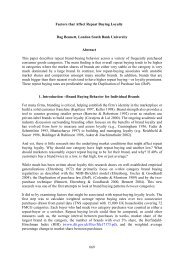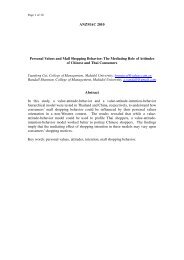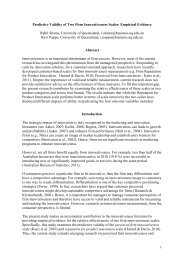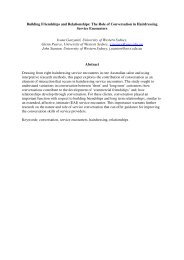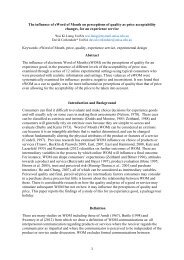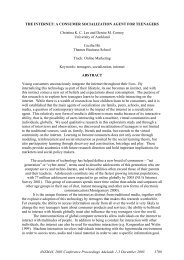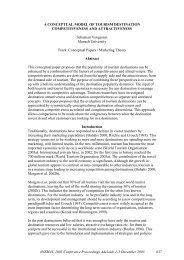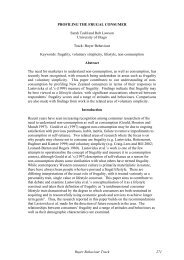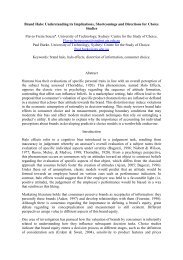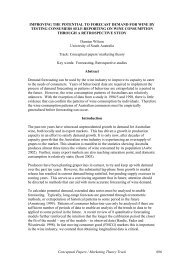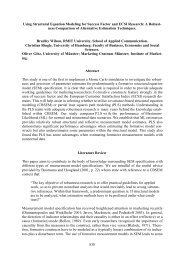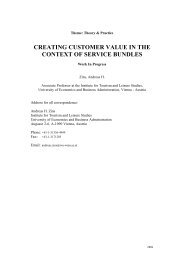amj Australasian Marketing Journal - ANZMAC
amj Australasian Marketing Journal - ANZMAC
amj Australasian Marketing Journal - ANZMAC
Create successful ePaper yourself
Turn your PDF publications into a flip-book with our unique Google optimized e-Paper software.
Table 2:<br />
Partial least squares results for the theoretical model<br />
For the latent variables, the bootstrap critical ratios (cr) (Chin,<br />
1998a,b) were acceptable (greater than 1.96) for all variables<br />
with the exception of age-self-monitoring, gender-materialism<br />
and self-monitoring-involvement. As such, hypothesised<br />
paths, 1a ,2b ,2c, 4a, 4b, 4d, and 4e (except for functional<br />
dimension) are supported and hypotheses , 1b, 2a and 4c are<br />
rejected.<br />
In the case of fashion clothing involvement, several of indices<br />
are supportive of the hypothesized relationships (Falk and<br />
Miller, 1992; Fornell and Cha, 1994). The loadings are all<br />
above .077, the bootstrap critical ratios are acceptable (i.e.,<br />
greater than 1.96) for those relationships supported.<br />
Therefore, the majority of the hypothesised relationships are<br />
supported. However, there were no significant relationships<br />
with the age-self-monitoring, gender-materialism and selfmonitoring-involvement.<br />
The formative measurement model was used for the motives<br />
Model<br />
Fashion Clothing Involvement<br />
Equation Predicted variables Predictor variables Hypothesis Path Variance a<br />
R 2<br />
Critical<br />
due to path ratio b<br />
1 Self-monitoring Gender H1a .091 .008 .009 1.964<br />
Age H1b .024 .001 .532<br />
2 Materialism Gender H2a -.021 .000 .070 -0.419<br />
Age H2b -.259 .066 -6.065<br />
Self-monitoring H2c .109 .010 2.224<br />
3 Motives Self-monitoring H3a .143 .040 .263 3.396<br />
Materialism H3b .498 .265 13.690<br />
4 Fashion clothing<br />
Involvement<br />
Gender H4a -.225 .109 .700 -8.894<br />
Age H4b .077 .066 2.984<br />
Self-monitoring H4c .031 .020 1.238<br />
Materialism H4d .127 .247 4.122<br />
Motives H4e .692 .642 25.655<br />
AVA (Average Variance Accounted) .692<br />
a These are only interpreted if the R 2 is greater than 0.10.<br />
b Bootstrap estimate divided by bootstrap standard error.<br />
and the manifest variables were assumed to be multiple causes<br />
of the latent variable (motives), and the weights rather than<br />
the loadings are used in evaluating the relationships. The<br />
weights are image .58 (cr 12.51), pleasure .48 (cr 9.61) and<br />
function -.03 (cr — 0.81).<br />
The basis for the evaluation of the full theoretical framework<br />
(Figure 1) is shown in Table 2. The average proportion of<br />
variance accounted (AVA) for the endogenous variables was<br />
.69 and the individual R2 were greater than the recommended<br />
.10 (Falk and Miller, 1992) for the predicted variables fashion<br />
clothing involvement (fashion clothing product involvement<br />
and fashion clothing purchase decision involvement). As all<br />
of these R2 estimates were larger than the recommended<br />
levels it is appropriate and informative to examine the significance<br />
of the paths associated with these variables.<br />
A reasonable criterion for evaluating the significance of the<br />
individual paths is the absolute value of the product of the<br />
<strong>Australasian</strong> <strong>Marketing</strong> <strong>Journal</strong> 9 (1), 2001 55



